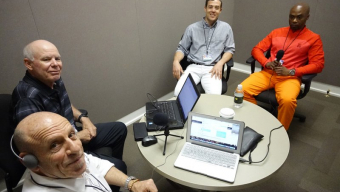AUGUSTA, Ga. — Valentino Dixon’s introduction to golf came when the warden dropped by his 6-by-10 cell at Attica Correctional Facility in New York with a photo of the iconic 12th hole at Augusta National and a simple request.
Could Dixon draw the hole with his colored pencils?
The warden knew Dixon had the talent. He certainly had the time.
“I hadn’t heard of the 12th hole, let alone Augusta National,” Dixon said. “Nothing about golf. Never paid a second of time to golf, it was always football or basketball where I come from.”
Dixon didn’t want to disappoint the warden while serving 39 years-to-life after being convicted of killing a man at a street party in his hometown of Buffalo in 1991. The warden, after all, held great sway over his living conditions in one of the nation’s most notorious — and dangerous — prisons.
But the last thing he wanted to do was irritate his fellow inmates.
“They might take my credibility card away, they may say he’s drawing golf courses, what’s going on here,” Dixon said. “You don’t want people to think, hey, he’s too close with the administration and this prison.”
So Dixon set about drawing. Some times that went on for 15 hours, with Dixon finding solace drawing the colors of the grass against the brilliantly white sand and blue sky .
The warden loved the image, though that’s hardly where this story ends. Dixon made more golf course drawings, hundreds of them from pictures he saw in Golf Digest and other magazines.
It wasn’t long before they found other eyes.
In their reflection, he found support and more believers in his innocence . His conviction was vacated last September, but not before he had spent 27 years in prison.
This week, Dixon found himself in a place far removed from his former home . He was at Augusta National for the Masters; it was both eerily familiar and strikingly foreign to him.
He walked down to Amen Corner and saw the 12th hole he knew only from pictures. He met Tiger Woods and Jack Nicklaus, whom he’d only seen in magazines.
It felt like home. The drawings had taken him here day after endless day, when there seemed no end in sight and no reason for hope.
“I just wanted to cry,” Dixon said. “I mean inside I was crying but I held back the tears, you know, because it’s just so much more remarkable and awesome in person. And I’ve drawn that 12th hole about eight or nine times and it’s nothing like seeing it in person — nothing. It’s just like the most wonderful thing that I can see in the world right now.”
After spending more than half his life in prison, Dixon might still be there if not for his art. He might be protesting his innocence, too, if not for a Golf Digest writer who answered his letter in 2011 as a submission to a monthly narrative called “How Golf Saved My Life.”
“Golf is saving my life right now because I had almost 20 years then and I was on borrowed time myself,” Dixon said. “I didn’t know if I was going to live one day to see it to the next.”
Some of his friends in Attica didn’t. They took their own lives.
“I made sure that I kept my sanity,” he said. “You know people lose their way.”
Golf Digest’s Max Adler set the wheels of justice in motion when he replied to Dixon’s letter. Seven more years passed before he was finally free.
“I was actually an art major in college, so it’s like this is golf and art and the human condition all coming together,” Adler said. “I’m of course skeptical that this guy is wrongfully convicted, but the fact that art was sort of a redemptive force for him. I thought I’d like to know more about that.”
Adler visited Dixon inside Attica, and saw his colored pencils ground down to the nub. His daughter Valentina’s efforts gathered more momentum as, first, two attorneys got involved and then even more when students from Georgetown University’s Prison Reform Project took up the cause. The final piece of the puzzle fell into place when a new prosecutor took over in Erie County and reviewed the case.
Another man already incarcerated pleaded guilty to the murder.
“Twenty-seven years, it’s just a miracle,” Adler said. “And it’s a miracle that we ever even heard from him.”
Dixon walked out of prison on a day filled with bright sunshine, eager to rejoin the free world. He had to learn how to use a cellphone and adjust to modern life after a generation behind bars. Now he gives inspirational speeches and shows his work in a gallery, most recently in New York.
Dixon says he’s not bitter. His mother, though, still bristles when the subject of his incarceration comes up. He was imprisoned on her birthday, and she refused to celebrate any of them for the next 27 years.
Dixon and Adler came to the Masters to complete their journey in the place it really began. His art brought him here, just as it freed him from prison.
“The artwork, it’s like God was speaking to my soul,” Dixon said. “He was just saying you know it’s gonna be all right, you hang in there.”





















